 advertisements advertisements
|

|
Unpacking Atlantis: Hubble mission mementos (STS-125 OFK)
June 20, 2020 — Space shuttle Atlantis landed in Florida Tuesday, nine days after touching down in California and completing the final mission to service the Hubble Space Telescope. Lowered from atop NASA's modified Boeing 747 that ferried it for the cross-country journey, Atlantis is now inside its processing facility, giving technicians their first chance at unpacking the orbiter.
On board, they will find a wide variety of items to be taken out before Atlantis can fly again. There's Hubble's longest serving camera, replaced during the mission, as well as the original "eyeglasses" that were installed to correct for the telescope's flawed mirror. Inside the crew cabin they'll find two basketballs, a baseball stadium's home plate and hundreds of patches designed by a "Star Trek" artist.
What they won't find, but what NASA's original plans first envisioned, is the Hubble Space Telescope itself.
Tears over a telescope
"We did originally plan to bring it back on the shuttle and put it in the Air and Space Museum," explained Hubble's senior project scientist David Leckrone to collectSPACE.
As popular as Hubble is — a grassroots effort is credited with helping resurrect this last servicing mission after its cancellation following the 2003 loss of shuttle Columbia — the telescope would have fit right in the museum.
Unfortunately, where it wouldn't fit — at least not after five servicing missions — is in Atlantis' payload bay.
"We made so many modifications — with the new solar arrays, by putting a radiator system on the outside of the telescope, by putting in instruments like the Advanced Camera for Surveys [that] we made it almost impractical to bring back," said Atlantis astronaut John Grunsfeld, who, including this mission, visited Hubble three times. "It would take as many spacewalks to remove all of these components and throw them into space in order to bring it back as it would to do a full servicing mission to extend its life, as we [did] on STS-125."
As Leckrone recalled, the decision not to risk astronauts' lives "for nothing but a museum exhibit" was not without regrets. "A lot of people shed tears about that," he stated.
The National Air and Space Museum in Washington, DC already exhibits a full-scale engineering model, as well as some of the instruments removed during previous shuttle visits. The museum's star Hubble artifacts are still waiting delivery, though.
A camera and its COSTAR
The most famous images taken by Hubble to date were all captured using the Wide Field Planetary Camera-2, or WFPC-2 (pronounced "whiff-pick-two"). Among its stellar shots were the Eagle Nebula's "Pillars of [star] Creation", the impact of comet Shoemaker-Levy 9 with Jupiter, and the "Deep Field", a long exposure that revealed a field of distant galaxies.
WFPC-2 was installed in 1993, during the first servicing mission. It was built to take into account a "spherical aberration", or flaw, in the telescope's primary mirror that was discovered after Hubble was launched in 1990. For the other instruments, astronauts on the same mission installed the "Corrective Optics Space Telescope Axial Replacement", or COSTAR, which used small mirrors to refocus the light hitting the cameras.
As newer instruments were added on subsequent shuttle missions, they were designed with the corrective optics already installed to the point that COSTAR was no longer needed and the space it took inside the telescope could be used to house another scientific instrument. STS-125 replaced COSTAR with the Cosmic Origins Spectrograph and then packed Hubble's "glasses" — and WFPC-2 — on Atlantis for the ride home.
Once unpacked from their carriers, both instruments are museum — and lab — bound.
"Our current plan is that we would initially display [them] at the Smithsonian for a small period of time, perhaps a month," shared Preston Burch, Hubble Program Manager at Goddard Space Flight Center, adding that the exhibit might be timed with a family day scheduled for October.
The instruments would then be shipped to Texas and the Johnson Space Center, where WFPC-2, in particular, is of interest to engineers.
"The external radiator on it has been a nice target for micrometeoroids over the 15 and a half years or so," said Burch. Studying the impacts will help scientists improve their understanding of the space environment.
"[They are] very keen to get their hands on that radiator," Burch explained.
There's a similar interest in studying the optics inside the camera and COSTAR, which will help calibrate the data received over the years.
"Once we are done doing that, we'd like to reassemble the instruments and put [them] on display," said Burch. WFPC-2 might first go to the Jet Propulsion Laboratory in California, which oversaw its original assembly, but then will return to Washington, DC.
"Its ultimate resting place would be the National Air and Space Museum," declared Burch.
Recycling Hubble history
Though WFPC-2's and COSTAR's roles in Hubble history justify their place in the Smithsonian, that the world's largest and most popular museum doesn't already have more of the observatory on display is not for a lack of interest, but the way in which Ball Aerospace assembled new instruments.
Just as WFPC-2 and COSTAR were replaced by Wide Field Camera-3 and Cosmic Origins Spectrograph (COS), they arrived in 1993 to take the place of WIde Field Planetary Camera-1 and High Resolution Spectrograph, or HRS.
"The HRS, when it was pulled out and came back — and Ball built that — we actually got that hardware back and we reused it to build the COS instrument," Mark LaPole, Ball's Hubble program manager, told collectSPACE. "And when Wide Field Planetary Camera-1 came back we also reused it to build Wide Field Camera-3. So the two new instruments that [were launched on STS-125] have quite a bit of recycled hardware."
Why reuse hardware instead of building new instruments?
"You could call it 'green'," joked LaPole, adding that it is "actually a great idea."
"The advantage of reusing is it is that we know it fits," he explained. "We know it goes right back into the hole" and sure enough, WFC3 and COS fit perfectly inside Hubble.
Even Ball's back-up hardware, duplicate parts created as spares, may still get reused.
"Some of it may go forward to another mission, another science mission," explained LaPole.
The same cannot be said for another, different group of Hubble hardware, though it has been extensively reused.
Located near the Johnson Space Center in Houston, the Sonny Carter Training Facility is the latest in a series of large, deep pools used by Hubble-bound astronauts to practice their servicing spacewalks underwater. Previous neutral buoyancy tanks have been located in Alabama and on-site at Johnson.
All of them have used the same full-size, three-segment mock-up of Hubble. With over 10,000 hours — more than a year — submerged in the three pools, supporting over 2,400 hours of hands-on training, astronauts spent more than 14-fold the time working with the mock-up than they did the real Hubble.
But with no more astronaut servicing missions scheduled, the fate of the underwater mock-up is up in the air.
"We're going to store it out back for the next three months, while working with our Goddard engineers as we figure out if we are going to ship it back to Goddard," said John Limongelli, who oversaw neutral buoyancy training for the STS-125 mission. "They may decide to use it somewhere else, at one of the space centers as a piece for visitors to see or at a museum."
"They haven't worked out the logistics of that yet," said Limongelli.
Other training mock-ups at Johnson and Goddard used outside the water may also be made museum exhibits in the future.
Hubble mission mementos
Not everything technicians unpack from Atlantis will be destined for museums. Some will be headed for sports stadiums, schools, community organizations and other groups that contributed to the astronauts' success while working on Hubble.
As with all shuttle missions, STS-125 had aboard a duffle bag-size "official flight kit" as well as smaller individual to each astronaut "personal preference kits" filled with small mementos for those the crew and NASA wanted to thank for their support.
Most of the items are banners, medallions, t-shirts, flags and pins but there are exceptions.
"One thing that is incredibly special to me," began John Grunsfeld in a pre-flight interview with collectSPACE, "I am bringing a Zeiss Maximar B camera."
"It belonged to... one of the greatest American explorers of all time," said Grunsfeld.
The 1929 model camera belonged to the late Bradford Washburn, who pioneered the use of aerial photography for mountaineering. One of his "pocket" cameras, this particular one was used to shoot what Washburn thought might be his last photographs after being stranded on a mountain. He hung the camera with its photographic plates from a tree in the hopes that someday, someone would find it and learn of his fate. Fortunately, he found rescue soon thereafter and recovered the camera himself.
Grunsfeld, a mountaineer himself, climbed Mt. McKinley, the highest mountain peak in North America, following the route that Washburn first mapped, and therefore felt a connection with the explorer. The two met and befriended each other before Washburn passed in January 2007.
"I went to visit him in December 2006, and he was in a retirement community," recalled Grunsfeld. "Above his bed — and you would think, here is a guy with kids and grandkids and family, and you would think he would just be surrounded by all these pictures — and right above his bed was a picture I had sent him years before of the Hubble Space Telescope, an 11 by 11 [inch] glossy. He thought that was just the coolest thing."
Grunsfeld flew the camera on behalf of the American Alpine Club, of which he is a life-long member, and it will go on display at the Washburn American Mountaineering Museum in Golden, Colorado. While in space, Grunsfeld planned to use it to take pictures of the Earth, including Mount Everest, as a tribute to Washburn, as well as take photos of his crewmates.
In addition to the camera, Grunsfeld also chose items to honor the space telescope's namesake, Edwin Hubble, and represent the observatory's astronomy mission. He packed a pocket telescope for the Adler Planetarium in Chicago, a 5-inch model of the Hubble telescope for the University of Colorado and a 1.5-inch telescope lens for the American Museum of Natural History located in New York.
The most unique of the Hubble-themed items though had to be the basketball that Edwin Hubble tossed around in 1909 when he was a starring forward on the University of Chicago's Maroons champion basketball team. The ball, which will go on display at the University's Gerald Ratner Athletics Center, was deflated before flight, though that offered a challenge as there was no valve as with modern basketballs, such as another that was on-board Atlantis.
Accompanying Hubble's basketball for its globe-trotting adventure was a ball from the Harlem Globetrotters. The exhibition team's signature red, white and blue ball will be placed at the Naismith Memorial Basketball Hall of Fame located in Springfield, Massachusetts.
Going from the court to the diamond, a home plate from the New York Mets' former park Shea Stadium was also on-board Atlantis.
Fellow STS-125 spacewalker Mike Massimino, a native of New York, is a Mets fan and asked the team for an item to fly.
"The home plate the Mets sent me is amazing. It has got all these cleat marks on it, it's got dirt on it, it's beautiful," described Massimino in an interview with collectSPACE. "It tells a story."
Unlike the basketballs though, there was no air to let out so that it could fit aboard the shuttle.
"We found that the way the black line is bonded to the plate, we can cut that with a sharp razor," he explained, so only the "white part" flew.
Boldly going where no one else will go again
Among the most abundant of the items to be unpacked from Atlantis and its official flight kit are replicas of the patch that the crew wore during the mission, the last to service Hubble.
"I contacted through a mutual friend Mike Okuda, who is the lead "Star Trek" artist," shared Grunsfeld, discussing the origin of the patch's design. "So we have a 'Star Trek' connection with the mission."
Collaborating with Grunsfeld, especially in regards to the astronomical symbols that the patch would depict, Okuda set to work.
"I started by asking 'What are the most important things about the mission?'," he wrote in an e-mail. "The answer was 1) the Hubble Space Telescope and 2) the incredible science that it has returned, that it will continue to return, thanks to everyone connected with this mission."
"To communicate this, I wanted to show that the Hubble is a magnificent spotlight that illuminates the wonders of the universe wherever it points. My unofficial title for the emblem is 'Hubble Illuminates the Cosmos', wrote Okuda.
"John specifically asked for the distant elliptical galaxy. He also wanted a red border to symbolize the red-shifted glow of the early universe." That "red-shift", which is the result of the universe expanding, is also referred to as the 'Hubble redshift' given Edwin Hubble's role in correlating years of observations to the realization that galaxies were receding from Earth at a rate that was proportional to their distance.
"I really wanted the Earth at the bottom of the emblem," described Okuda, "but that ended up competing with the Hubble Space Telescope and making the design more cluttered than necessary. So I cut the Earth. (I figured most folks would know what planet Hubble and Atlantis came from, anyway.)" |
|

John Grunsfeld and Drew Feustel stow the Hubble telescope's longest serving camera on-board Atlantis for its return. (NASA)
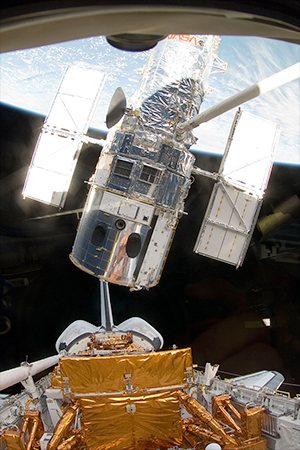
Hubble is released back into orbit by the STS-125 crew. (NASA)
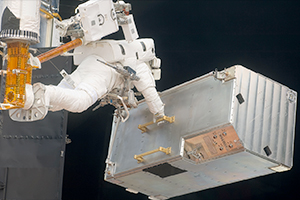
Drew Feustel moves COSTAR, the Hubble telescope's original "eyeglasses" into Atlantis' cargo hold to return home. (NASA)

The Hubble neutral buoyancy training mock-ups removed from the water for the last time. (collectSPACE)
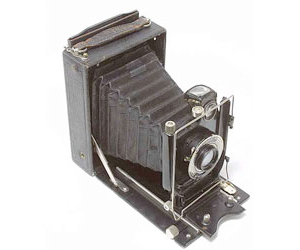
Bradford Washburn's Zeiss Maximar B (Mountaineering Museum)
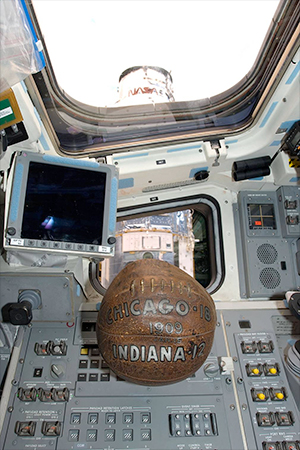
Edwin Hubble's 1909 University of Chicago basketball floats in space in front of the Hubble Space Telescope. (Univ. of Chicago)
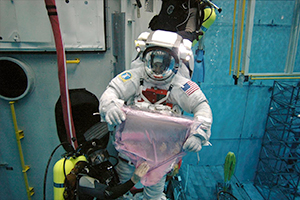
Mike Massimino holds the New York Mets' home plate he'd later fly into space aboard Atlantis. (NASA)
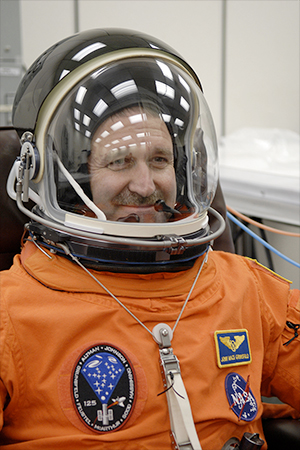
ohn Grunsfeld, suited for launch, wears the patch he and Mike Okuda worked together to design. (NASA) |
The STS-125 Official Flight Kit Manifest
The following is the STS-125 Official Flight Kit manifest, as provided by NASA. Inventory numbers that are missing indicate items that were removed prior to launch.
|
No.
|
|
Description
|
|
Sponsor/Purpose
|
|
|
1.
|
|
-
625 STS-125 crew patches
-
75 Expedition patches
|
|
Agency Presentation
|
2.
|
|
600 Small United States Flags
|
|
Agency Presentation
|
3.
|
|
4 Sets U.S. States & Territories Flags
|
|
Agency Presentation
|
4.
|
|
4 Sets United Nations Members Flags
|
|
Agency Presentation
|
5.
|
|
-
20 Small Texas Flags
-
5 Small NASA Flags
-
5 Small POW MIA Flags
-
1 11"x13" Mississippi State University Flag
-
5 NASA Patches
-
5 Texas Lapel Pins
-
1 Bronze NASA Seal Medallion
-
1 Silver Shuttle Pendant
-
6 Small JSC Medallions
|
|
Agency Presentation
|
6.
|
|
10 Small Flags of the Following States:
-
Illinois
-
Texas
-
Washington
-
California
|
|
Agency Presentation
|
7.
|
|
5 Small Flags of the Following U.S. States:
-
Ohio
-
Florida
-
Colorado
-
Michigan
|
|
Agency Presentation
|
8.
|
|
2 Small Flags of the Following U.S. States:
-
Indiana
-
Idaho
-
Alabama
-
Arkansas
-
Oregon
-
Arizona
-
New York
-
Vermont
|
|
Agency Presentation
|
9.
|
|
Small International Flags:
-
4 Canada
-
2 Italy
-
2 Israel
-
2 Vatican
-
2 India
-
2 Czech Republic
-
10 Spain
|
|
Agency Presentation
|
10.
|
|
10 Each Small Military Flags:
-
U.S. Air Force
-
U.S. Army
-
U.S. Coast Guard
-
U.S. Marine Corps
-
U.S. Navy
|
|
Agency Presentation
|
11.
|
|
-
10 Small United States Flags
-
10 Small Alabama State Flags
|
|
Marshall Space Flight Center Presentation
|
12.
|
|
-
10 Small Louisiana State Flags
-
10 Small Mississippi State Flags
-
5 Small NASA Flags
-
5 Small United States Flags
|
|
Stennis Space Center Presentation
|
13.
|
|
-
2 Small United States Flags
-
2 Small Florida State Flags
-
10 Small KSC Coins
|
|
Kennedy Space Center Presentation
|
14.
|
|
140 Silver Snoopy Pins
|
|
Space Flight Awareness Presentation
|
|
|
15.
|
|
25 EVA Patches
|
|
Agency Presentation
|
16.
|
|
-
10 STS-125 Crew Patches
-
20 Small U.S. flags
-
1 Wake Forest NC Police Department Patch
-
10 DoD Space Test Program Patches
-
10 DoD Space Test Program 40th Anniversary Coins
|
|
DoD Presentation
|
17.
|
|
15 STS-120 Crew Patches
|
|
United Space Alliance Presentation
|
|
|
18.
|
|
20 Constellation Lapel Pins
|
|
Constellation Program Office Presentation
|
|
|
19.
|
|
50 MOD Patches
|
|
Mission Operations Directorate Presentation
|
|
|
20.
|
|
Small Computer Memory Stick
|
|
Agency Presentation
|
|
|
21.
|
|
100 Metal Shuttle Tokens
|
|
Agency Presentation
|
|
|
22.
|
|
Small Deflated Basketball
|
|
Agency Presentation
|
|
|
23.
|
|
100 Small Enamel Ribbon Lapel Pins
|
|
Agency Presentation
|
|
|
Items 24 through 100 are manifested at the request of the STS-125 crewmembers.
|
|
|
24.
|
|
3'x4' Gold colored fabric
|
|
Tazewell Historic Society, Pekin IL
|
|
|
25.
|
|
8"x12" White Fabric With Logo
|
|
Illinois Space Society, Champaign, IL
|
|
|
26.
|
|
University of Illinois Medallion
|
|
University of Illinois, Champaign, IL
|
|
|
27.
|
|
Blue Orion Patch
|
|
Crew Exploration Vehicle Project Houston, TX
|
|
|
28.
|
|
Blue Orion Decal
|
|
Crew Module Project, Houston, TX
|
|
|
29.
|
|
Black Shirt With Logo
|
|
1-91st Calvary-173rd Airborne Combat Team, Naray/Nuristan, Afghanistan
|
|
|
30.
|
|
Black School Shirt
|
|
Clear Springs High School, League City, TX
|
|
|
31.
|
|
Navy Blue School Banner
|
|
Georgetown University, Washington, DC
|
|
|
32.
|
|
11"x14" Vinyl Banner
|
|
STS Limousine, Friendswood, TX
|
|
|
33.
|
|
6.5"x8" White Oval Patch
|
|
Challenger Learning Center, Bloomington, IL
|
|
|
34.
|
|
Beige School Shirt
|
|
Schmitz Park Elementary, Seattle, WA
|
|
|
35.
|
|
5"x7" White Fabric
|
|
Kenmore Air, Kenmore, WA
|
|
|
36.
|
|
16"x26" Red and White Fabric
|
|
U.S. Coast Guard, Port Arthur, TX
|
|
|
37.
|
|
Small Blue School Pennant
|
|
Big Bend Community College, Moses Lake, WA
|
|
|
38.
|
|
Blue and White School Basketball Jersey
|
|
West Seattle High School, WA
|
|
|
39.
|
|
Museum Patch
|
|
Museum of Flight, Seattle, WA
|
|
|
40.
|
|
Blue Triangular Patch
|
|
Intruder Association, Norfolk, VA
|
|
|
41.
|
|
Multicolored Test Pilot School Patch
|
|
U.S. Air Force Test Pilot School, Edwards AFB, CA
|
|
|
42.
|
|
Black and Gold Patch
|
|
The Society of Experimental Test Pilots, Lancaster, CA
|
|
|
43.
|
|
Photo Negative Reproduction
|
|
Astrophysics Science Division, Greenbelt, MD
|
|
|
44.
|
|
Green and Blue Nylon Pants
|
|
National Outdoor Leadership School, Lander, WY
|
|
|
45.
|
|
White Conductor's Baton
|
|
Houston Symphony Orchestra, Houston, TX
|
|
|
46.
|
|
2'x4' Blue and Black Flag
|
|
Space Telescope Science Institute, Baltimore, MD
|
|
|
47.
|
|
58"x35" Green, Blue and Brown Banner
|
|
National Geographic Society, Washington, DC
|
|
|
48.
|
|
7.5"x14" Black, Red and Gold Banner
|
|
Arizona State University, Tempe, AZ
|
|
|
49.
|
|
8"x10" MIT Engineers Banner
|
|
Massachusetts Institute of Technology, Cambridge, MA
|
|
|
50.
|
|
Black and Blue Triangular Patch
|
|
American Astronomical Society, Washington, DC
|
|
|
51.
|
|
Blue and White Patch
|
|
Mountain Rescue Association, Mount Hood, OR
|
|
|
52.
|
|
5.5" Collapsible Pocket Telescope
|
|
Alder Planetarium, Chicago, IL
|
|
|
53.
|
|
5"x5.5" Hubble Space Telescope Model
|
|
University of Colorado, Boulder, CO
|
|
|
54.
|
|
31"x43" Light Blue Vinyl Banner
|
|
Tel Aviv University, Tel Aviv, Israel
|
|
|
55.
|
|
Gray School Shirt
|
|
Columbia University, New York, NY
|
|
|
56.
|
|
White School Shirt
|
|
Rice University, Houston, TX
|
|
|
57.
|
|
Black Shirt
|
|
National Baseball Hall of Fame, Cooperstown, NY
|
|
|
58.
|
|
1.5" Round Black Telescope Lens
|
|
American Museum of Natural History, New York, NY
|
|
|
59.
|
|
13.5" White Conductor's Baton
|
|
Clear Lake High School, Houston, TX
|
|
|
60.
|
|
Book Cover
|
|
Massachusetts Institute of Technology Museum, Cambridge, MA
|
|
|
61.
|
|
1.5" Round Silver Robot Part
|
|
Westbrook Intermediate School, Friendswood, TX
|
|
|
62.
|
|
34"x57" Black Astros Flag
|
|
Houston Astros, Houston, TX
|
|
|
63.
|
|
White USA Olympic Swimming Cap
|
|
U.S. Olympic Swim Team, Portland, ME
|
|
|
64.
|
|
White Bean Bag Drum Without Beans
|
|
Purdue University, West Lafayette, IN
|
|
|
65.
|
|
Gold Medallion
|
|
Indian Space Research Organization, Bangalore, India
|
|
|
66.
|
|
Black Beanie Hat
|
|
Department of Earth and Atmospheric Sciences, Ithaca, NY
|
|
|
67.
|
|
2006 U.S. Open Ticket Stub
|
|
U.S. Tennis Association, White Plains, NY
|
|
|
68.
|
|
Yellow, Red and Blue Flag
|
|
Queens University, Kingston, Ontario
|
|
|
69.
|
|
Black School Shirt
|
|
Oakland Community College, Bloomfield Hills, MI
|
|
|
70.
|
|
6.5"x7.5" White and Green Athletic Letter "O"
|
|
Lake Orion High School, Lake Orion, MI
|
|
|
71.
|
|
8" Round Cymbal
|
|
Tragically Hip Band, Kingston, Ontario
|
|
|
72.
|
|
36"x60" White and Green Flag
|
|
City of Cornwall, Cornwall, Ontario
|
|
|
73.
|
|
Black and Gold Patch
|
|
Ottawa Police Department, Ottawa, Ontario
|
|
|
74.
|
|
Blue, Black and Silver Medallion
|
|
746 Test Squadron, Holloman AFB, NM
|
|
|
75.
|
|
Silver Medallion
|
|
Christus St. John Hospital, Nassau Bay, TX
|
|
|
76.
|
|
35.5x58" Navy Blue Flag
|
|
Notre Dame Air Force ROTC, Notre Dame, IN
|
|
|
77.
|
|
17"x34" Blue and Gold Banner
|
|
University of Notre Dame, Nortre Dame, IN
|
|
|
78.
|
|
23"x38" Red and Yellow Banner
|
|
Brecksville High School, Cleveland, OH
|
|
|
79.
|
|
Large White Jersey
|
|
Cleveland Indians, Cleveland, OH
|
|
|
80.
|
|
Silver Pen
|
|
Girard Associates, Middleburg Heights, OH
|
|
|
81.
|
|
Aerospace Magazine Cover
|
|
Aerospace Manufacturing and Design, Richfield, OH
|
|
|
82.
|
|
Patch
|
|
New York City Sanitation Department, New York, NY
|
|
|
83.
|
|
4"x6.5" Red, White and Black Athletic Letter "C"
|
|
H. Frank Carey High School, Franklin Square, NY
|
|
|
84.
|
|
Patch
|
|
Marine Physical Lab at University of California, San Diego, CA
|
|
|
85.
|
|
2"x2.5" Gray and Green Tonga Trench Rock
|
|
Birch Aquarium at Scripps, San Diego, CA
|
|
|
86.
|
|
White Banner
|
|
National Parks Service, Washington, DC
|
|
|
87.
|
|
18"x28" Banner
|
|
Scripps Institution of Oceanography, San Diego, CA
|
|
|
88.
|
|
50th Anniversary Patch
|
|
Timber Cove Neighborhood, CA
|
|
|
89.
|
|
6"x3"x2" Aluminum Block Processor Replica
|
|
University of California, Los Angeles, CA
|
|
|
90.
|
|
Gold Medallion
|
|
St. Francis High School, Mountain View, CA
|
|
|
91.
|
|
2'x3' U.S. Flag
|
|
International Sub Races, Blacksburg, VA
|
|
|
92.
|
|
2'x3' U.S. Flag
|
|
City of Wenatchee, Wanatchee, WA
|
|
|
93.
|
|
Small Maroon and Gold Pennant
|
|
Eureka College, Eureka, IL
|
|
|
94.
|
|
Gold Astronaut Pin
|
|
Agency Presentation
|
|
|
95.
|
|
Gold Astronaut Pin
|
|
Agency Presentation
|
|
|
96.
|
|
Gold Astronaut Pin
|
|
Agency Presentation
|
|
|
97.
|
|
Gold Astronaut Pin
|
|
Agency Presentation
|
|
|
98.
|
|
Gold Astronaut Pin
|
|
Agency Presentation
|
|
|
99.
|
|
Gold Astronaut Pin
|
|
Agency Presentation
|
|
|
100.
|
|
Gold Astronaut Pin
|
|
Agency Presentation
|
|
|
101.
|
|
2 Each 12"x18" NASA 50th Anniversary Banners
|
|
Agency Presentation
|
|
|
102.
|
|
Conductor's Baton
|
|
Agency Presentation
|
|
|
103.
|
|
17"x35" Green Banner
|
|
Agency Presentation
|
|
|
Items 104 through 108 are manifested at the request of the Space Shuttle Program Office.
|
|
|
104.
|
|
700 Sheets of SSP Bookmarks
|
|
Space Shuttle Program Office Presentation
|
|
|
105.
|
|
1,000 Small (4"x6") Flags
|
|
Space Shuttle Program Office Presentation
|
|
|
106.
|
|
5,643 Assorted HST Patches
|
|
Space Shuttle Program Office Presentation
|
|
|
107.
|
|
257 Small International Flags
|
|
Space Shuttle Program Office Presentation
|
|
|
108.
|
|
35 Payload Patches (10 MAUI, 25 RAMBO)
|
|
Space Shuttle Program Office Presentation
|
|
|

© 1999-2025 collectSPACE. All rights reserved.
|
|

|

|
